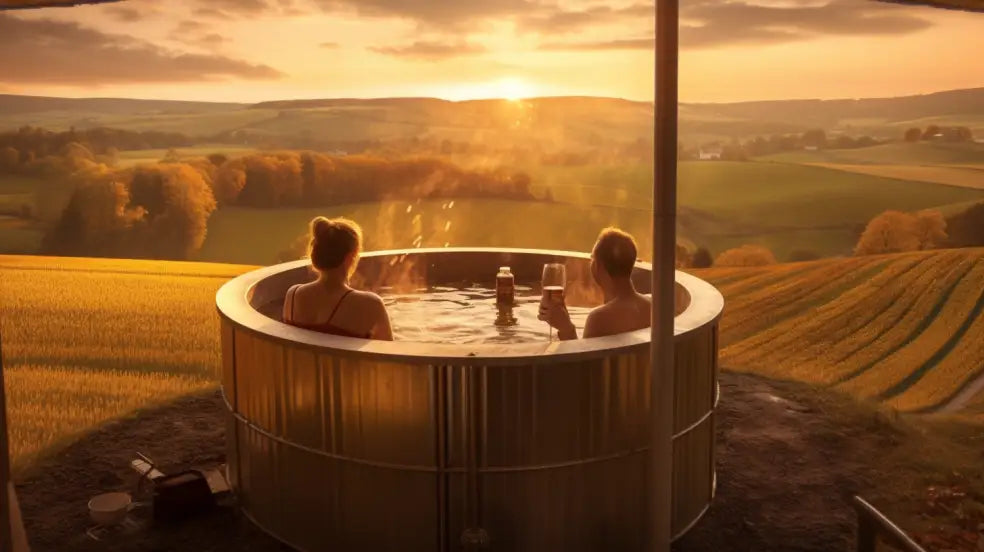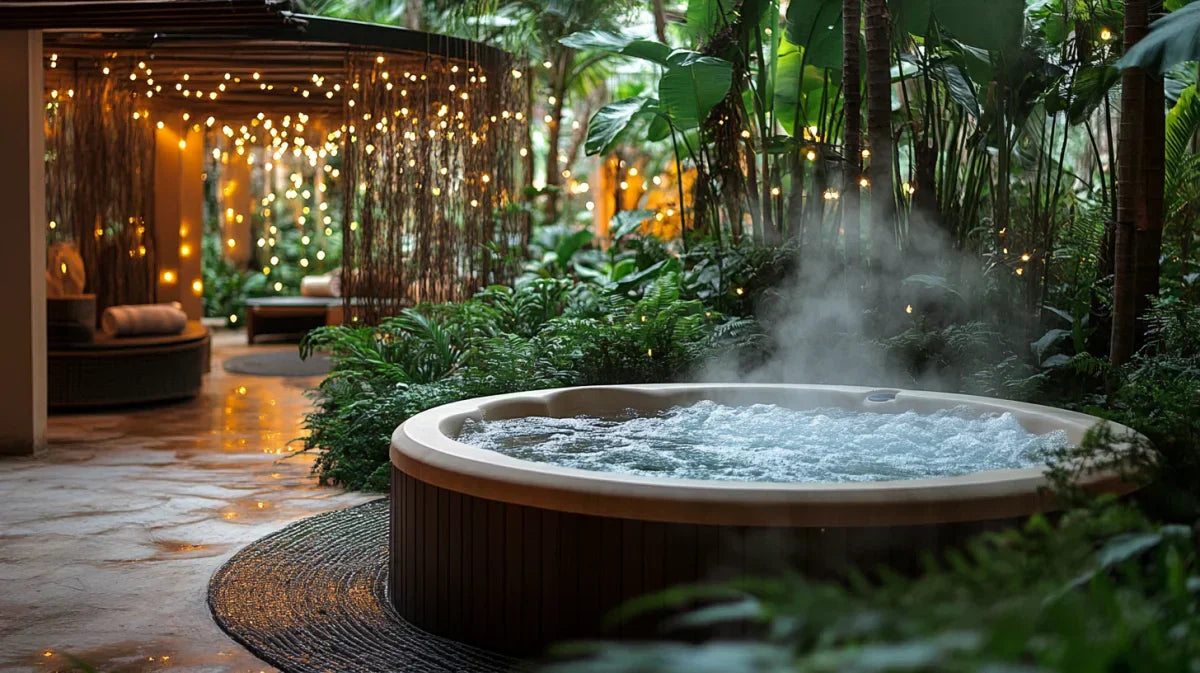The Warm, Natural Beauty of a Wooden Hot Tub
Ah, the sweet smell of cedar or redwood on a warm summer night... There's nothing quite like lounging in a well crafted wooden hot tub and soaking up the heat while surrounded by family, loved ones, friends or nature's beauty. Wooden hot tubs have been around for centuries and continue to be popular today offering a natural aesthetic that metal or plastic tubs simply can't match.
Wooden hot tubs are also incredibly versatile in terms of design most often allowing extensive customization of your hot tub to fit your unique style and preferences; From round to square, small to large, wooden hot tubs can be crafted to fit any size or space. Plus, they blend seamlessly into outdoor environments, enhancing the natural beauty of any backyard or patio.
Popularity Breeds Popularity
It's absolutely no secret that wooden hot tubs are popular - just take a look at their continued presence in spas and resorts worldwide... But, their popularity is not limited to commercial settings as more homeowners are choosing wooden hot tubs for their personal use as well. So, why are so many people turning to wooden hot tubs?
A major part, is because hot tubs in general offer an escape from the fast-paced world we live in and a soak in a wooden hot tub is therapeutic for both body and mind - it helps you relax and de-stress after a long day at work or strenuous activity. But the popularity of wooden hot tubs goes beyond just relaxation benefits - they're also seen as an investment in one's property value. As more homeowners look to create luxurious outdoor living spaces, incorporating amenities like a wooden hot tub is becoming increasingly common.
The Advantages of Wooden Hot Tubs
Natural Aesthetic Appeal
One of the biggest advantages of wooden hot tubs is their natural beauty. The rich, warm tones and natural grain patterns of the wood give these hot tubs a unique, organic look that simply can’t be replicated with plastic or metal materials, adding a touch of rustic charm to any backyard space and making them the perfect addition to a cabin or country home.
Durability and Longevity
Another benefit of wooden hot tubs is their durability and longevity. When properly maintained, a well-made wooden hot tub can last for decades. Unlike plastic or metal materials which can easily crack or rust over time, wood has been used for centuries to create long-lasting structures that stand up well to the elements.
Retains Heat Well
Wooden hot tubs are also known for their ability to retain heat well. The thickness of the wood used in construction helps to insulate the water inside, meaning that it stays warm for longer periods of time than other types of materials might allow. This makes it possible to use your hot tub even on chilly evenings without having to worry about constantly heating it up.
Easy Maintenance
Maintaining a wooden hot tub is generally quite easy. Regular cleaning and treating with solutions designed specifically for wood will help keep it looking great and functioning properly for years to come. While some types of wood may require more intensive maintenance than others (such as regular oiling), overall upkeep should not be overly burdensome even for someone without much experience in this area.
Disadvantages of Wooden Hot Tubs
Higher initial cost compared to other materials
Let's talk about the elephant in the room: wooden hot tubs are not cheap. In fact, they can be quite expensive, especially when compared to plastic or fiberglass alternatives. But here's the thing – you get what you pay for. A wooden hot tub is an investment that will last you a lifetime if properly cared for. Sure, you could opt for a cheaper alternative and have to replace it every few years, but why bother with that hassle? Plus, let's not forget about the natural beauty and aesthetic appeal that only wood can provide.
Requires regular maintenance
Yes, wooden hot tubs require maintenance. But guess what? So do all types of hot tubs! If you want your investment to last for years to come, then it only makes sense that you would need to put in some effort to maintain it. And honestly, is a little bit of maintenance really that big of a deal? Regular cleaning and treating with appropriate oils or stains will keep your wooden hot tub looking brand new and prevent any potential issues from occurring.
Wooden Hot Tubs Are Susceptible to rot and decay - if not properly cared for
Ah yes, the dreaded fear of rot and decay. It's true – if you neglect your wooden hot tub and fail to provide proper care and maintenance, then it could potentially suffer from rot and decay over time... But let me ask you this: would you buy a car without ever changing its oil or taking it in for regular maintenance? Of course not! And the same principle applies here – if you want your investment to last, then commit yourself to providing proper care and maintenance. : yes, there are some potential downsides to owning a wooden hot tub.
But these downsides pale in comparison to the benefits that wood provides. A wooden hot tub is not just a functional addition to your backyard – it's a statement piece that adds natural beauty and class to your home. So go ahead, take the plunge, and invest in a wooden hot tub. Your future self (and your sore muscles) will thank you.
Types of Wood Used for Hot Tubs
Cedar Wood Hot Tubs
When it comes to wooden hot tubs, cedar is one of the most popular choices for good reason. Cedar is known for its natural resistance to decay and insect infestations, making it an ideal wood for outdoor use. This type of wood also has a lovely aroma that adds to the relaxing atmosphere of a hot tub. Not only does cedar have great natural resistance properties, but it is also an excellent insulator, which means it will retain heat well. This makes it more energy efficient and will save you money in the long run. Cedar also has natural oils that help prevent water absorption, which makes maintenance easier overall.
Redwood Hot Tubs
Another popular option for wooden hot tubs, redwood is a durable and long-lasting wood that has been used in construction for centuries. Redwood is naturally resistant to decay and insects due to its high tannin content. It also has a beautiful color and grain pattern that adds to the aesthetic appeal of a hot tub. In addition to its natural resistance properties, redwood is also easy to work with and can be carved or shaped into different designs. It's important to note that redwood requires more maintenance than cedar as it can absorb water if not sealed properly.
Teak Wood Hot Tubs
Teak is another hardwood commonly used in hot tub construction due to its durability and strength. It's known for being weather-resistant and can withstand exposure to extreme temperatures without contracting or expanding excessively like other woods might. One major benefit of teak is that it requires very little maintenance compared with other woods such as redwood or cedar. Its natural oil content helps protect against rotting and damage from moisture. Teak also has a unique golden-brown color that deepens with time adding depth and character over the years.
Other Hardwoods
In addition to cedar, redwood, and teak, there are other hardwoods that can be used for hot tub construction. These include but are not limited to oak, mahogany, and eucalyptus. Each type of wood has its own unique characteristics that may make it more or less suitable for your specific needs. When deciding on a type of wood for your hot tub, it's important to consider factors such as durability, maintenance requirements, and aesthetic appeal. Ultimately the choice will depend on personal preference and budget.
Installation and Maintenance Tips for Wooden Hot Tubs
Proper Installation Techniques
If you're going to invest in a wooden hot tub, don't skimp on the installation. Proper installation is key to ensuring your hot tub lasts as long as possible and functions correctly. This means hiring a professional or following the manufacturer's instructions carefully if installing it yourself. Firstly, ensure that the surface beneath your hot tub is sturdy enough to support its weight when filled with water.
This might mean pouring a concrete slab or reinforcing an existing deck. Secondly, make sure you have easy access to the plumbing and electrical connections for repairs or maintenance down the line. One critical factor in proper installation is ensuring that your hot tub has proper drainage to prevent water from accumulating under or around it. Failure to do so can lead to rot, decay, and other structural issues over time.
Regular Cleaning and Maintenance Tips
Maintaining a wooden hot tub can be more intensive than maintaining one made of plastic or fiberglass, but the beauty of natural wood makes it worth it. Regular cleaning and maintenance are essential for preventing mold growth, staining from minerals in hard water, and other damage.
To clean your wooden hot tub, use only gentle cleansers specifically designed for use on wood surfaces such as baking soda-based cleaners; avoid harsh chemicals like bleach and ammonia. Use a soft-bristled brush or cloth when cleaning so as not to scratch or damage the wood surface.
Additionally, emptying your hot tub between uses will help reduce wear on its interior finish caused by chlorine exposure over extended periods of time. And don't forget about maintaining your filter system regularly!
Avoiding Common Mistakes That Can Damage The Wood
One common mistake people make with wooden hot tubs is allowing leaves, twigs, and debris to accumulate on top of their cover, causing the wood to rot and decay. Another common mistake is not checking the pH levels of the water regularly, which can cause corrosion of metal components in the hot tub.
It's important to note that wooden hot tubs require more care than plastic or fiberglass ones but with proper maintenance, they can last for decades! Avoiding mistakes like using harsh chemicals or leaving debris on top of your cover will help extend its life and maintain its natural beauty.
Health Benefits of Using a Wooden Hot Tub
Improved circulation and cardiovascular health
If you're looking for a way to improve your cardiovascular health, look no further than soaking in a wooden hot tub. The heat from the hot tub causes your blood vessels to dilate, which increases blood flow and lowers your blood pressure. This increased circulation also leads to better oxygenation of your muscles and tissues, resulting in improved overall health. But it's not just your heart that will benefit from soaking in a wooden hot tub. The heat also stimulates the production of endorphins, which are natural painkillers that can help reduce stress levels and alleviate pain.
Reduced stress levels
Speaking of reducing stress levels, there's nothing quite like soaking in a wooden hot tub after a long day at work. The warm water and soothing jets create the perfect environment for relaxation, helping to ease tension in both your body and mind. In fact, studies have shown that spending time in a hot tub can lower cortisol levels (the hormone associated with stress) and increase serotonin production (the hormone associated with happiness). So if you're looking for an all-natural way to combat chronic stress, consider investing in a wooden hot tub.
Relief from muscle pain and soreness
Whether you suffer from chronic muscle pain or simply have sore muscles after working out, soaking in a wooden hot tub can provide much-needed relief. The heat helps to increase blood flow to your muscles, which promotes healing and reduces inflammation. Additionally, the buoyancy of the water helps take pressure off your joints and allows you to move more freely. This makes it easier to stretch out tight muscles without putting too much strain on them.
All in all, there are plenty of health benefits associated with using a wooden hot tub. From improved cardiovascular health to reduced stress levels and relief from muscle pain, soaking in a hot tub is a great way to improve your overall well-being.
Environmental Impact of Wooden Hot Tubs
Wooden hot tubs may be aesthetically pleasing and provide health benefits, but we cannot ignore the environmental impact they have. The production of wooden hot tubs contributes to deforestation, habitat destruction and loss of biodiversity. Manufacturing a single hot tub requires cutting down several mature trees and processing them into planks. This has a significant impact on our forests, which are already under pressure from human activities such as logging, agriculture, infrastructure development among others.
Sustainability concerns with harvesting wood for hot tubs
The process of harvesting wood for hot tubs is not sustainable in the long run. Most manufacturers source wood from old-growth forests or tropical rainforests, which are already threatened ecosystems. These trees take decades to grow and mature, meaning that it takes a long time for the forest ecosystem to recover from their loss.
Moreover, logging practices can cause soil erosion and degradation leading to water pollution and reduced soil fertility. Additionally, intensive logging operations may harm wildlife habitats by fragmenting forests into smaller patches or completely removing essential habitat components such as large trees.
Eco-friendly alternatives to traditional wooden hot tubs
Fortunately, there are eco-friendly alternatives to traditional wooden hot tubs that can help reduce their environmental impact. One such option is using recycled plastic or composite materials that mimic real wood but do not require cutting down trees or causing deforestation. Another option is using locally sourced wood from sustainably managed forests where new trees are planted after every harvest cycle. This ensures that the harvested tree population is constantly being replenished while also supporting local communities who rely on these resources for their livelihoods.
While wooden hot tubs may offer some benefits such as aesthetic appeal and health benefits, they have an undeniable negative impact on the environment through deforestation and habitat destruction. It's essential that we consider the environmental impact of our actions and opt for eco-friendly alternatives such as recycled materials or sustainably sourced wood.
Conclusion: Are Wooden Hot Tubs Any Good?
After a thorough examination of the advantages, disadvantages, types of wood used, installation and maintenance tips, health benefits, and environmental impact of wooden hot tubs, it is safe to say that wooden hot tubs are indeed good. While there are certainly some downsides to owning a wooden hot tub such as the higher cost and required maintenance, these factors are outweighed by the many benefits that come with using one. The natural aesthetic appeal of wooden hot tubs cannot be matched by any other material. The warmth and feel of wood adds a certain charm and cozy ambiance to any backyard or patio.
If you're in the market for a new outdoor spa experience or looking for ways to upgrade your current setup - consider investing in a high-quality wooden hot tub! With proper care, good quality insulation, and maintenance these structures can provide years of relaxation, enjoyment, and health benefits for you and your loved ones.



